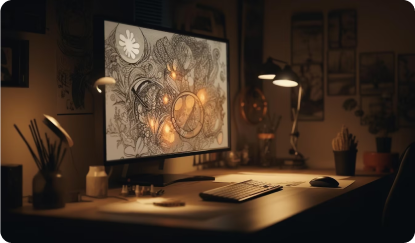AUTHOR
SOPHIA ROBERTS
Published Date
3 JULY 2024
Category
DESIGN
Read Time
5 MINUTES

The Essence of Minimalism in Design
In the realm of design, the essence of minimalism lies in the deliberate choice to distill complexity and convey a powerful message through simplicity. It's an art form that celebrates the beauty of space, emphasizing the significance of each carefully chosen element. A minimalist design isn't about deprivation; rather, it's a conscious decision to focus on the core, allowing the audience to engage with a visual narrative that is both refined and impactful. As we explore the essence of minimalistic design, we uncover the subtle nuances that contribute to its allure. The use of negative space, a hallmark of minimalism, creates breathing room within the composition, allowing the viewer's gaze to rest and appreciate the inherent beauty of the design. The simplicity in form and color becomes a canvas for expression, where every line and shade tells a story. By embracing minimalism, designers have the opportunity to communicate more with less, fostering a connection that transcends visual aesthetics. At its core, minimalism in design challenges conventional notions, encouraging a shift from excess to essence. It invites both creators and consumers to engage in a thoughtful dialogue with the visual elements, promoting a sense of mindfulness and intentionality. The essence of minimalistic design, therefore, lies not just in its visual appeal but in the profound impact it has on the way we perceive and interact with the world of design.
Minimalism Beyond Aesthetics
Beyond its visually captivating exterior, minimalism is a design philosophy that permeates every aspect of the creative process, extending its influence far beyond the surface. This philosophy becomes a lens through which designers view their craft, shaping not just what is seen but how it is experienced. The minimalist approach transcends mere aesthetics; it becomes a mindset that emphasizes clarity, functionality, and a deeper connection with the audience. Minimalism, as a philosophy, challenges the notion that complexity is synonymous with sophistication. It prompts designers to question the necessity of each element, encouraging a meticulous evaluation of form and function. This shift in perspective extends to the user experience, where the removal of unnecessary clutter allows for a seamless and intuitive interaction. Beyond creating visually pleasing designs, the minimalist philosophy becomes a guiding force for designing experiences that are inherently user-centric.
Practical Tips for Mastering Minimalistic Design
The journey to mastering minimalistic design involves a practical exploration of principles and techniques that breathe life into the philosophy. It begins with an understanding of the psychology of color in minimalism, where the strategic use of a limited color palette contributes to the overall impact of the design. The intentional choice of typography plays a pivotal role, guiding the viewer through the visual narrative with clarity and purpose. Navigating the terrain of minimalistic design also involves a keen awareness of the power of negative space. Far from being empty, this space becomes a deliberate pause, allowing the audience to absorb and appreciate the essential elements of the composition. Striking the right balance between simplicity and sophistication is an art in itself, requiring a discerning eye and a commitment to the core principles of minimalism. Practical tips extend beyond the theoretical, delving into the day-to-day decisions that shape a minimalist design. From the selection of imagery to the judicious use of graphic elements, each choice contributes to the overall impact. Mastery in minimalistic design is not merely about adherence to a set of rules; it's about developing an intuition that guides the creative process, ensuring that every design decision serves a purpose and contributes to the cohesive whole.
TESTIMONIALS
Prestige turned our business around!
Their digital marketing strategies helped us reach new customers and increase our revenue by 30% within just a few months. Highly recommended!

Sarah Thomas
CEO of BlueBloom
Completely exceeded our expectations
Their web development team is very professional, they coded our website's design into an awesome working site, which was responsive, bug free and extremely eye catching.

John Benson
Director of Brainwave
Working with Prestige was a pleasure.
Their web design team created a stunning website that perfectly captured our brand's essence. The feedback from our customers has been overwhelmingly positive.

Lisa Williams
CEO Of HealthTech
Prestige's web design brought our vision
Their responsive design ensures our website looks stunning on all devices, contributing to increased user engagement.

Jennifer Lee
COO of Food Haven
FREQUENTLY ASKED QUESTIONS
How long does it take to complete a web development project?

The timeline varies depending on the project type and requirements, generally a web development project is completed within 2 weeks.
Can you handle large-scale mobile app development projects?

We can and we have handled large scale mobile app development projects, we have worked with many multinationals worldwide.
Can you integrate third-party APIs into our mobile app?

Yes, We can integrate third-party APIs into any mobile app, it's your project, it will be exactly how you want it to be.
How do you ensure cross-platform compatibility and responsiveness for websites?

Each web app is developed with a proper roadmap and is extensively tested on different devices through management softwares, our engineers always make sure that each website is completely responsive and compatible for all platforms.
What is your approach to user experience (UX) design?

Our team works closely to ensure user friendly experience in our each product, whether it's an app or a website, in the modern era user friendly experience is crucial as it results in potential customers.











